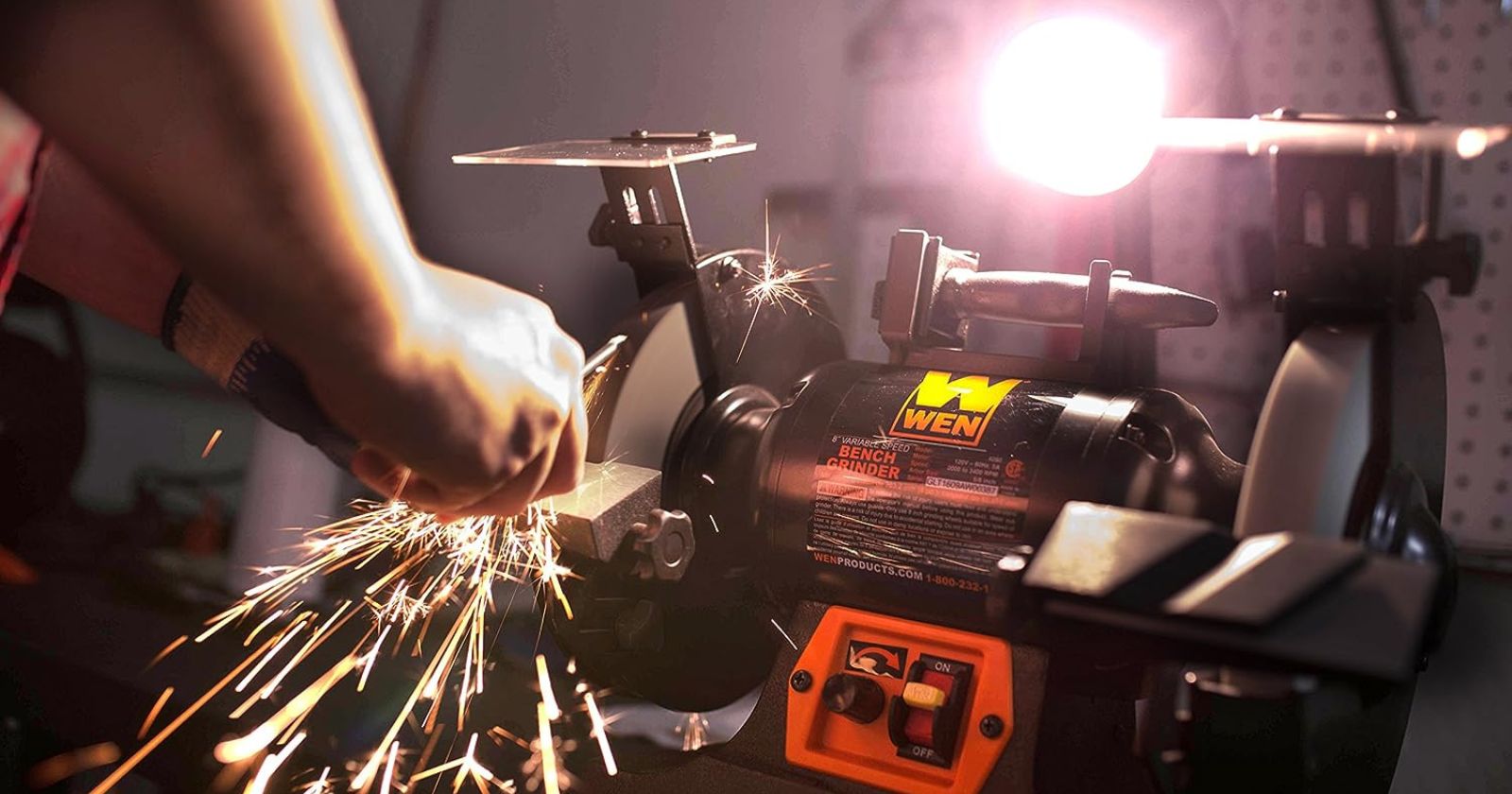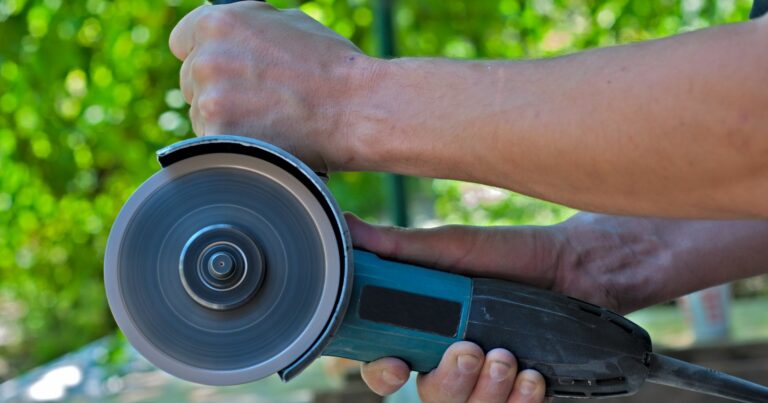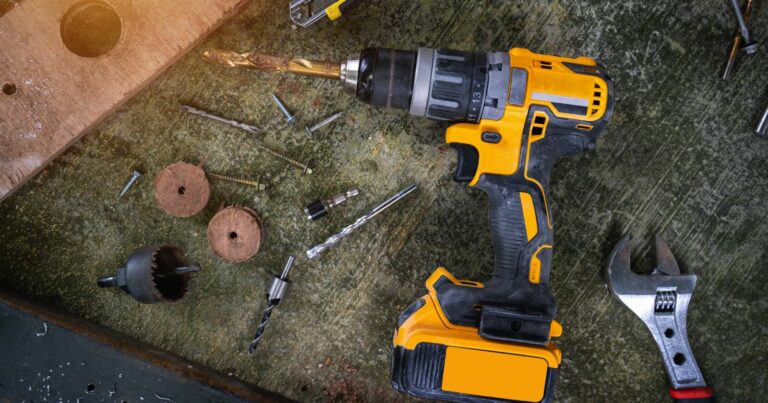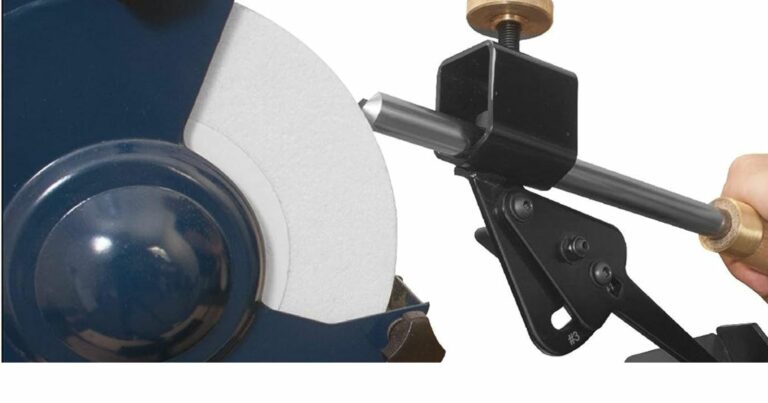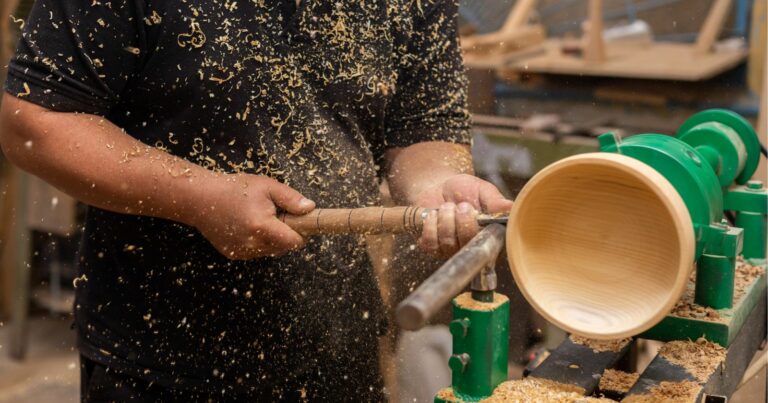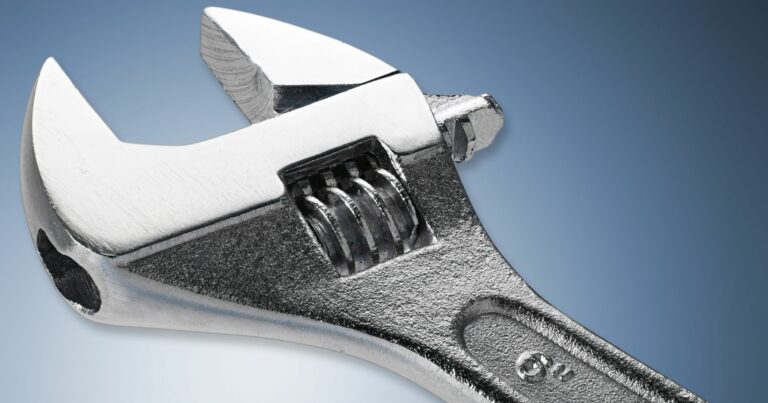The 5 Best Slow Speed Bench Grinders for Sharpening: A Beginner’s Guide for 2024
In my many years in woodworking and metalworking, I’ve learned that sharp tools are the cornerstone of precision and quality work. Whether you’re like me, a seasoned professional, or just starting out as a DIY enthusiast, we can all agree that a dull tool is our worst enemy. That’s why I always turn to the best slow speed bench grinders for sharpening. Specifically designed for this purpose, the best slow speed bench grinder has become my go-to tool, breathing new life into my tools and providing me with sharp edges that cut like new.
For me, a slow speed bench grinder is more than just a tool; it’s an essential piece of equipment in my workshop. The slower speed reduces the risk of overheating my tools during the sharpening process, preserving their hardness and ensuring a sharp, durable edge. In this guide, I’ll take you through the world of the best slow speed bench grinders for sharpening, sharing my insights and helping you choose the best one for your needs. So, grab your tools, and let’s get started!
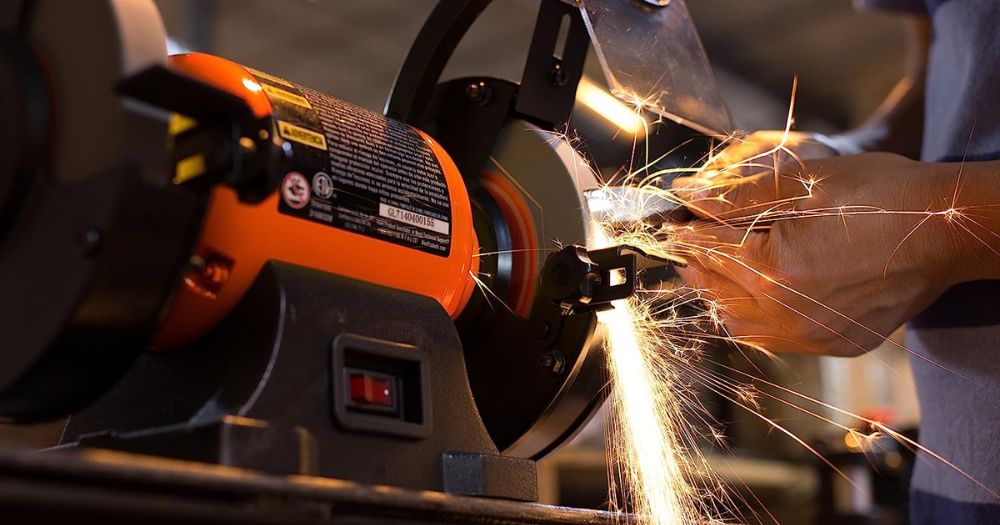
What is a Slow Speed Bench Grinder?
In my journey as a tool enthusiast, I’ve encountered a myriad of tools, each with their unique functions. But if you ask me to pick a favorite, the slow speed bench grinder would undoubtedly be on the top of my list. So, what’s so special about it?
A slow speed bench grinder is a power tool that’s been a game-changer in my workshop. Unlike the high-speed grinders, it operates at a slower speed, usually around 1750 RPM. This slower speed is a godsend as it minimizes the risk of overheating my tools during sharpening, preserving their hardness and delivering a sharper edge.
You might be wondering, why go for a slow speed bench grinder for sharpening? Well, let me share some of the benefits that have made it an indispensable part of my toolkit:
- Precision Sharpening: The slower speed gives me more control over the sharpening process. I can make tiny adjustments to achieve the perfect edge on my tools.
- Reduced Overheating: High-speed grinders can often cause tools to overheat during sharpening, which can compromise the tool’s hardness. With a slow speed grinder, this risk is significantly mitigated.
- Versatility: While sharpening is its primary function, my slow speed bench grinder is also great for other tasks. I use it for shaping, polishing, and cleaning various types of materials.
- Longer Tool Life: By maintaining a sharp edge on my tools, my slow speed bench grinder has extended the life of my tools, saving me a significant amount of money in the long run.
In my book, a slow speed bench grinder is an invaluable tool for any craftsman, be it a professional or a DIY enthusiast. It’s a worthy addition to any workshop. In the following sections, I’ll guide you on how to choose the best slow speed bench grinder for your needs and share some of my top picks. So, stick around!
Factors to Consider When Choosing a Slow Speed Bench Grinder for Sharpening
Choosing the right slow speed bench grinder for sharpening can feel like a daunting task, especially with the plethora of options available out there. But fear not, I’m here to guide you through it. Over the years, I’ve found several key factors that help me make the right choice:
Motor Power: The heart of any bench grinder is its motor. The power it packs determines the performance of the grinder. A high-power motor will sharpen tools faster and more efficiently. But from my experience, for most home users, a grinder with a motor power between 1/2 to 1 HP does the job perfectly.
Wheel Size and Material: The size and material of the grinding wheel are equally important. The wheel size dictates the type of tools you can sharpen. Larger wheels are great for bigger tools, while smaller wheels are suitable for smaller tools.
When it comes to material, I’ve found aluminum oxide wheels to be a popular choice for sharpening steel tools. They’re durable and provide a smooth finish. But if you’re like me and occasionally work with harder materials like carbide, you might want to consider a silicon carbide wheel.
Price and Brand: It’s tempting to go for the cheapest option, but let me tell you, you often get what you pay for. Renowned brands usually offer better quality and durability. They also tend to provide better customer service and warranty options.
But this doesn’t mean you should always break the bank. It’s about finding a balance between cost and quality. I always consider my budget, but I also take into account the grinder’s features and the reputation of the brand.
In the next section, I’ll share my personal favorites – the best slow speed bench grinders for sharpening that have proven to be reliable and efficient in my workshop. So, stick around!
Top 5 Best Slow Speed Bench Grinders for Sharpening
Finding the best slow speed bench grinder for sharpening can feel like navigating a maze, especially with the plethora of options out there. But fear not, I’ve done the hard work for you. Here are my top 5 picks that have proven to be reliable, efficient, and worth every penny:
1. Rikon Professional Power Tools 80-805

My personal favorite, the Rikon Professional Power Tools 80-805, is a powerhouse. Equipped with a 1/2 HP motor, it provides just the right amount of power for all my sharpening needs. The 8-inch wheels are perfect for a variety of tools.
Pros
The Rikon Professional Power Tools 80-805, an essential tool I wouldn’t be without as a dedicated craftsman. I rely on its powerful motor for efficient sharpening, which saves me both time and effort in my projects. The large wheel size is a standout feature for me, offering unmatched versatility to handle a broad spectrum of sharpening tasks. What’s more, the 80-805 is built to endure, with a durable construction that stands up to the most rigorous use. When I use the Rikon Professional Power Tools 80-805, I’m confident in a reliable, high-performance tool that consistently delivers on power and durability
Cons
Relatively expensive compared to other bench grinders on the market
2. : JET 577102 JBG-8A

Another excellent choice is the JET 577102 JBG-8A. It features a robust 1 HP motor and high-quality 8-inch wheels, making it a great addition to any workshop.
Pros
I find the JET 577102 JBG-8A to be an exceptional tool that consistently delivers reliable performance for all my sharpening needs. I’m particularly impressed with its robust motor, which provides steady power, and the high-quality wheels that allow for precision work. This combination makes the JET 577102 JBG-8A my go-to choice when I need efficiency and quality in my tools.
Cons
The JET 577102 JBG-8A is not suitable for heavy-duty tasks.
3. WEN 4280

If you’re on a budget, the WEN 4280 is a good option. Despite its lower price, it doesn’t compromise on quality. The 5-amp motor is sufficient for most sharpening tasks, and the 8-inch wheels are versatile enough for different tools.
Pros
I find the WEN 4280 to be both affordable and versatile, truly standing out in its category. Its wide range of applications makes it an invaluable asset in my workshop. One feature I particularly appreciate is its quiet operation, which contributes to a more comfortable working environment. With the WEN 4280, I’ve found a cost-effective solution that doesn’t compromise on versatility or my comfort
Cons
The WEN 4280 is not as powerful as other models on the market.
4. Delta Power Tools 23-197

The Delta Power Tools 23-197 is a versatile and reliable tool. It’s a bit more expensive, but the features and performance are worth the investment. The variable speed control is a standout feature, allowing me to adjust the speed to suit my sharpening needs.
Pros
The Delta Power Tools 23-197 holds a special place due to its variable speed control, which allows for precise and adaptable performance. I’m impressed by its durable construction, which promises longevity, and the smooth operation that ensures a user-friendly experience. If you, like me, value control, durability, and ease of use in your tools, the Delta Power Tools 23-197 is an excellent choice
Cons
The Delta Power Tools 23-197 is slightly higher priced.
5. Shop Fox W1840

Last but not least, the Shop Fox W1840 is a high-quality and durable tool. It’s a bit pricier, but the excellent motor power, wheel size, and material make it a worthy investment.
Pros
I find the Shop Fox W1840 to be a robust tool, thanks to its powerful motor that ensures efficient operation. I appreciate its large wheel size, which enhances its versatility and makes it suitable for a wide range of tasks. Its durable construction, built to withstand rigorous use, makes the Shop Fox W1840 a reliable choice for me, especially when I’m seeking power and durability in my tools.
Cons
The Shop Fox W180 comes at a higher price point.
Remember, the best slow speed bench grinder for you depends on your specific needs and budget. Consider the factors I’ve mentioned, and you’ll be able to find a grinder that’s perfect for you. In the next section, I’ll share some of my personal tips on how to use your slow speed bench grinder for sharpening. So, stick around!
How to Sharpen Tools Using a Slow Speed Bench Grinder
Sharpening tools using a slow speed bench grinder is a skill that’s saved me a lot of time and money. Let me walk you through how I do it:
Safety First: Before I even start, I make sure I’m kitted out in proper safety gear. This includes safety glasses, ear protection, and work gloves. I also ensure my grinder is securely mounted on a stable surface.
Prepare Your Tool: I always clean my tool with a wire brush to remove any rust or debris. This ensures a smooth and effective sharpening process.
Set the Tool Rest: I adjust the tool rest so that it’s at the right angle for my tool. Typically, this is a 25 to 30-degree angle for most tools.
Start the Grinder: I turn on the grinder and let it reach its full speed before I start sharpening.
Sharpen Your Tool: I hold my tool firmly and press it against the grinding wheel. I move the tool back and forth across the wheel, maintaining the correct angle at all times. Remember, it’s the edge of the tool I’m sharpening, not the entire surface.
Check Your Progress: I periodically check my progress. My goal is to sharpen the tool until I have a sharp edge, but I’m careful not to overdo it. Over-sharpening can weaken the tool.
Hone the Edge: After sharpening, I hone the edge of the tool using a honing stone for a razor-sharp finish.
Here are some of my personal tips and tricks for effective sharpening:
Don’t Rush: Sharpening is a process that requires patience. I don’t rush it. I let the grinder do the work.
Keep It Cool: Overheating can damage your tools. I dip my tool in water periodically to keep it cool during the sharpening process.
Maintain the Angle: Consistency is key when it comes to sharpening. I always maintain the correct angle to ensure an even edge.
Remember, practice makes perfect. The more you sharpen, the better you’ll get at it. So, don’t be discouraged if you don’t get it right the first time. Keep practicing, and you’ll be a sharpening pro in no time!
Safety Tips When Using a Slow Speed Bench Grinder
Safety is paramount when using any power tool, and a slow speed bench grinder is no exception. Over the years, I’ve learned that taking a few extra precautions can make a world of difference. Here are some safety tips that I always follow when using my bench grinder:
- Wear Safety Gear: This is the golden rule. I never start grinding without my safety glasses, work gloves, and ear protection. The glasses protect my eyes from sparks and debris, the gloves shield my hands from hot metal shavings, and the ear protection helps to prevent any potential hearing damage from the grinder’s noise.
- Check the Grinder: Before I even switch on the grinder, I make sure it’s securely mounted on a stable surface. I also inspect the grinding wheels for any cracks or damage. If I spot any, I replace the wheel immediately. It’s never worth the risk to use a grinder with a damaged wheel.
- Use the Right Wheel: Different materials require different types of grinding wheels. I always make sure to use the right wheel for the material I’m working with. Using the wrong wheel can not only damage the tool but also pose a safety risk.
- Let the Grinder Reach Full Speed: After turning on the grinder, I give it a few moments to reach its full speed before I start grinding. This ensures that the grinder is working properly and reduces the risk of the wheel jamming or the tool kicking back.
- Work at the Right Angle: I always hold my tool at the correct angle to the grinding wheel. This reduces the risk of the tool slipping and causing an accident. It also ensures a more effective and even sharpening process.
- Don’t Overreach: I make sure to keep a firm footing and maintain a balanced stance at all times. Overreaching or using excessive force when grinding can lead to loss of control and potential accidents.
- Let the Grinder Stop Naturally: After I’m done grinding, I turn off the grinder and let it stop naturally. I never try to stop the wheel with my hand or any other object. It’s safer and better for the grinder’s longevity.
- Keep a Clean Work Area: I always keep my work area clean and free of any clutter. This reduces the risk of tripping or knocking something onto the grinder.
- Regular Maintenance: Regular maintenance of the grinder ensures it stays in top condition and is safe to use. I regularly check and replace the grinding wheels, clean the tool rests, and lubricate any moving parts.
Remember, safety should always be your top priority when using a slow speed bench grinder. By following these safety tips, you can ensure a safe and productive grinding experience. Stay safe and happy grinding!
FAQs
Over the years, I’ve fielded a lot of questions about slow speed bench grinders. It seems like everyone’s got a query or two about this handy tool. So, I thought it would be helpful to share some of the most common questions I get asked, along with my personal responses. Hopefully, these will give you some extra insights and help you get the most out of your slow speed bench grinder.
Why do I personally prefer a slow speed bench grinder over a regular speed grinder for sharpening?
Well, it all comes down to control and preservation of the tool. A slow speed bench grinder operates at a lower speed, usually around 1750 RPM. This slower speed reduces the risk of overheating the tools during the sharpening process, which can compromise the tool’s hardness and performance. Plus, the slower speed gives me more control over the sharpening process, allowing me to achieve a sharper and more precise edge.
Do I use my slow speed bench grinder for tasks other than sharpening?
Answer: Absolutely! While sharpening is my primary use for my slow speed bench grinder, it’s also a champ at other tasks. I use it for shaping, polishing, and cleaning various types of materials. It’s a versatile tool that’s earned its place in my workshop.
How often do I replace the grinding wheel on my slow speed bench grinder?
Answer: The frequency of replacing the grinding wheel really depends on how often you use your grinder and the materials you’re working with. In my case, I replace the wheel when it’s worn down to about 1 inch in diameter or if it’s damaged. I always make it a point to check the condition of the wheel before using my grinder. It’s a simple step that ensures both safety and effectiveness.
Conclusion
Sharpening tools is an indispensable skill for any craftsman, and a slow speed bench grinder is the ideal tool for the task. In this comprehensive guide, I’ve shared my personal insights and experiences to help you understand not only the importance of a slow speed bench grinder, but also how to choose the best one for your needs, and how to use it safely and effectively.
Remember, the best slow speed bench grinder for you is one that suits your specific needs and budget. While I’ve shared my top picks, such as the Rikon Professional Power Tools 80-805 and the JET 577102 JBG-8A, it’s essential to remember that what works best for me might not be the perfect fit for you. By considering the factors I’ve outlined, including motor power, wheel size and material, and price and brand, you’ll be able to find a grinder that’s just right for you.
When it comes to using your bench grinder, safety should always be your top priority. Always wear the appropriate safety gear, including safety glasses, ear protection, and work gloves. Follow the safety tips I’ve shared, such as checking the grinder before use, using the right wheel, and letting the grinder stop naturally. And remember, practice makes perfect. The more you sharpen, the better you’ll get at it, and the more satisfaction you’ll get from your work.
In the end, investing in a slow speed bench grinder is a decision you won’t regret. It not only keeps your tools sharp, ensuring precision in your work, but also extends their lifespan, saving you money in the long run. It’s an essential tool in my workshop, and I believe it will be in yours too.
So, if you don’t have one in your workshop yet, I highly recommend getting one. You’ll soon wonder how you ever managed without it. And remember, every craftsman is as good as their tools, and with a slow speed bench grinder, your tools will be at their best.
Happy grinding, and here’s to many successful projects ahead!
More Bench Grinder Post:
Since You’re Here Check Out Some More Bench Grinder Based Posts I Wrote

